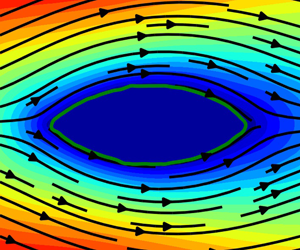Crossref Citations
This article has been cited by the following publications. This list is generated based on data provided by
Crossref.
Lino, Mario
Fotiadis, Stathi
Bharath, Anil A.
and
Cantwell, Chris D.
2022.
Multi-scale rotation-equivariant graph neural networks for unsteady Eulerian fluid dynamics.
Physics of Fluids,
Vol. 34,
Issue. 8,
Haridas, Akash
Vadlamani, Nagabhushana Rao
and
Minamoto, Yuki
2022.
Deep neural networks to correct sub-precision errors in CFD.
Applications in Energy and Combustion Science,
Vol. 12,
Issue. ,
p.
100081.
Sun, Yang
Elhanashi, Abdussalam
Ma, Hao
and
Chiarelli, Mario Rosario
2022.
Heat Conduction Plate Layout Optimization Using Physics-Driven Convolutional Neural Networks.
Applied Sciences,
Vol. 12,
Issue. 21,
p.
10986.
Zapata Usandivaras, José Felix
Urbano, Annafederica
Bauerheim, Michael
and
Cuenot, Bénédicte
2022.
Data Driven Models for the Design of Rocket Injector Elements.
Aerospace,
Vol. 9,
Issue. 10,
p.
594.
Lino, Mario
Fotiadis, Stathi
Bharath, Anil A.
and
Cantwell, Chris D.
2023.
Current and emerging deep-learning methods for the simulation of fluid dynamics.
Proceedings of the Royal Society A: Mathematical, Physical and Engineering Sciences,
Vol. 479,
Issue. 2275,
Rosset, Nicolas
Cordonnier, Guillaume
Duvigneau, Regis
and
Bousseau, Adrien
2023.
Interactive design of 2D car profiles with aerodynamic feedback.
Computer Graphics Forum,
Vol. 42,
Issue. 2,
p.
427.
Zhou, Hongjie
Xie, Fangfang
Ji, Tingwei
Zhang, Xinshuai
Zheng, Changdong
and
Zheng, Yao
2023.
Fast transonic flow prediction enables efficient aerodynamic design.
Physics of Fluids,
Vol. 35,
Issue. 2,
Merdasi, Arshia
Ebrahimi, Saman
Yang, Xiang
and
Kunz, Robert
2023.
Physics Informed Neural Network application on mixing and heat transfer in combined electroosmotic-pressure driven flow.
Chemical Engineering and Processing - Process Intensification,
Vol. 193,
Issue. ,
p.
109540.
Chen, Li-Wei
and
Thuerey, Nils
2023.
Towards high-accuracy deep learning inference of compressible flows over aerofoils.
Computers & Fluids,
Vol. 250,
Issue. ,
p.
105707.
Zhao, Jiachi
Zeng, Lifang
and
Shao, Xueming
2023.
A novel prediction method for unsteady aerodynamic force on three-dimensional folding wing aircraft.
Aerospace Science and Technology,
Vol. 137,
Issue. ,
p.
108287.
Xu, Yuhang
Wei, Yingjie
Sha, Yangyang
and
Wang, Cong
2023.
A novel model with an improved loss function to predict the velocity field from the pressure on the surface of the hydrofoil.
Ocean Engineering,
Vol. 283,
Issue. ,
p.
115123.
Kim, Min-Il
Yoon, Hyun-Sik
and
Seo, Jang-Hoon
2023.
Deep Learning Models for the Evaluation of the Aerodynamic and Thermal Performance of Three-Dimensional Symmetric Wavy Wings.
Symmetry,
Vol. 16,
Issue. 1,
p.
21.
Hu, Jiawei
and
Zhang, Weiwei
2023.
Flow field modeling of airfoil based on convolutional neural networks from transform domain perspective.
Aerospace Science and Technology,
Vol. 136,
Issue. ,
p.
108198.
Lv, Xinkai
Xie*, Cui
Dong, Junyu
and
Chang*, Xiaofeng
2023.
Fast Prediction of Sailboat Aerodynamic Coefficients using Multi-Scale Residual 3D Unet.
p.
340.
Chen, Di
Kumar, Prashant
Kametani, Yukinori
and
Hasegawa, Yosuke
2024.
Multi-objective topology optimization of heat transfer surface using level-set method and adaptive mesh refinement in OpenFOAM.
International Journal of Heat and Mass Transfer,
Vol. 221,
Issue. ,
p.
125099.
Herrmann, Leon
and
Kollmannsberger, Stefan
2024.
Deep learning in computational mechanics: a review.
Computational Mechanics,
Vol. 74,
Issue. 2,
p.
281.
Ataei, Mohammadmehdi
and
Salehipour, Hesam
2024.
XLB: A differentiable massively parallel lattice Boltzmann library in Python.
Computer Physics Communications,
Vol. 300,
Issue. ,
p.
109187.
Brahmachary, Shuvayan
and
Thuerey, Nils
2024.
Unsteady cylinder wakes from arbitrary bodies with differentiable physics-assisted neural network.
Physical Review E,
Vol. 109,
Issue. 5,
Fok, Priscilla Jia Yuan
Liu, Pengfei
Kandasamy, Ranjith
and
Wong, Teck Neng
2024.
Thermal performance of cold plates with novel pin-fins designed using Bézier curves.
International Journal of Thermal Sciences,
Vol. 195,
Issue. ,
p.
108611.
Travnikov, Vladislav
Plokhikh, Ivan
and
Mullyadzhanov, Rustam
2024.
Advancing graph neural network architecture for fluid flow and heat transfer surrogate modeling: Variable boundary conditions and geometry.
Physics of Fluids,
Vol. 36,
Issue. 12,



